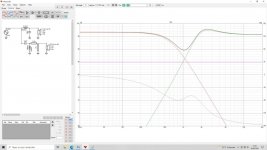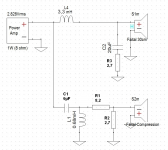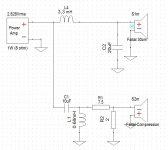The HF10AK is a larger 1" exit driver, I bet there are better and cheaper drivers for 8 kHz and up.Anyone have an impulse response measurement on the HF10AK on an STH100 or indeed any generally similar horn that they could share here? (or privately by PM) I need a sanity check. I have an apparent ringing problem that might have everything or nothing at all to do with the driver/horn combo. I run them as tweeters from 8kHz up.
There might be, OTOH they are what I've got. I think I have identified the root cause of the ringing - my DSP.The HF10AK is a larger 1" exit driver, I bet there are better and cheaper drivers for 8 kHz and up.
Here is a measurement I took in July that I forgot about, the ringing isn't present. (Tested using Topping Dac to power amp to horn, Umik-2, REW) Power amplifier is 300B SE with a source impedance of just under 2 ohms.
HF10AK on STH100 at 30cm
I run HF-10AK drivers on STH100 horns and while I only experimented briefly I found the performance unsatisfactory at 1kHz, above 2kHz the combination is good. Note that this was not one of my more rigorous experiments, possibly a larger horn would work better? (I cross to them at 9kHz so pure tweeter duty).
Hi, if you already have the driver and DSP I suggest you try it, the steep slope might help it*. I did briefly try low xo point and it wasn't good, but could have been some other reason than hf10ak like error in my DSP setting. If you don't already have it yet, and plan for low crossover point you should pick another driver like BMS 5530 or 4544 or something, that can actually do a low crossover point not to risk it. If you have possibility, you could buy few different drivers and test them out which sounds best to you in your system.
One main reason to use compression driver at all is to have good SPL capable system. Game with lowering crossover point is that the sound starts to suffer and SPL is lost, and evetually low SPL doesn't sound right. And all you can do is buy more suitable driver or change the plan.
* steep slopes with IIR filters do not seem to sound as good as low order filters, except got one ok with linear phase FIR. Here I had massive issues with measurement data and hownI made the response to a target, "too low" crossover actually resulted quite big boost below xo point to match the "ideal slope", so be careful when you implement such filter, lots of possibilities to have it sound bad. Have fun!🙂
One main reason to use compression driver at all is to have good SPL capable system. Game with lowering crossover point is that the sound starts to suffer and SPL is lost, and evetually low SPL doesn't sound right. And all you can do is buy more suitable driver or change the plan.
* steep slopes with IIR filters do not seem to sound as good as low order filters, except got one ok with linear phase FIR. Here I had massive issues with measurement data and hownI made the response to a target, "too low" crossover actually resulted quite big boost below xo point to match the "ideal slope", so be careful when you implement such filter, lots of possibilities to have it sound bad. Have fun!🙂
Forgot to mention that I'm having 3 way speakers, hf10ak, 8" mid and 15" bass and the system can do just about enough good sounding SPL in a living room settings to have a nice party, but bigger space or outside it gets into stressed sounding quite easily. While this could be also from my amplification or my implementation overall, first thing that starts to sound irritating when too loud is the treble, first suspect is the driver making nasty sound for some reason. My xo is around 1.5k or so, some passive parts to pad and high pass but it's active system otherwise. I've recently built bigger system for a friend and went directly to 1.4" driver to get some more headroom for party. While these 1" drivers can sound quite remarkable and loud, plenty loud enough in "basic home use" there is a limit somewhere, you just have to find it whether the limit is troubling to you.
Last edited:
If it struggles that much maybe there is an alternative driver maybe something Berillium or ROSSO-65CDN-T or beyma tpl-150h?
Well, struggling is relative term 🙂 It works just fine most of the time in home setting, especially when xo is not unnecessarily low. Just trying to give a perspective whether it would work for you or not. It works for me fine enough but, there is likely better drivers also for my application.
Infact, I'm not sure if drivers have too different of a sound, as long as a driver is suitable for the particular application and the system design is done with the application in mind. Because by then, there is likely quite specific criterion for a driver and it's just easy to pick. I think it is very backwards to first pick a driver based on hype and marketing, and then go and design system around that. While it could work just fine I just think it's very backwards way to do it.
For example, 65CDN and TPL 150H are physically very different transducers, so would result for at least a bit different (optimal) system, IOW they are not replaceable with each other for given system that is well designed. I mean, if you design a system and it calls for 1" compression driver these aren't, right. if you design a system that calls for 1.4" the 65CDN might do, if it is physically suitable size to fit and enough power handling capacity, correct price etc. sound is likely fine when it is a good fit for application because the measurements look good so it's a problem free driver, unless you make the crossover too low or try to get too much SPL out of it and so on. For example hf10ak isn't a problem free driver looking the frequency response alone, but it still sounds just fine unless out of bounds.
Just trying to give perspective on things 🙂
Infact, I'm not sure if drivers have too different of a sound, as long as a driver is suitable for the particular application and the system design is done with the application in mind. Because by then, there is likely quite specific criterion for a driver and it's just easy to pick. I think it is very backwards to first pick a driver based on hype and marketing, and then go and design system around that. While it could work just fine I just think it's very backwards way to do it.
For example, 65CDN and TPL 150H are physically very different transducers, so would result for at least a bit different (optimal) system, IOW they are not replaceable with each other for given system that is well designed. I mean, if you design a system and it calls for 1" compression driver these aren't, right. if you design a system that calls for 1.4" the 65CDN might do, if it is physically suitable size to fit and enough power handling capacity, correct price etc. sound is likely fine when it is a good fit for application because the measurements look good so it's a problem free driver, unless you make the crossover too low or try to get too much SPL out of it and so on. For example hf10ak isn't a problem free driver looking the frequency response alone, but it still sounds just fine unless out of bounds.
Just trying to give perspective on things 🙂
Struggles is a good description of what I heard below 2kHz with the STH100 horn.
I've been rolling custom devices, here is how https://www.diyaudio.com/community/threads/acoustic-horn-design-the-easy-way-ath4.338806/
- Home
- Loudspeakers
- Multi-Way
- Faital HF146 vs HF10AK - Top End Performance


